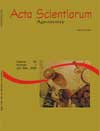<b>Decomposição e liberação de nutrientes das palhadas de milheto e milheto + crotalária no plantio direto do feijoeiro</b> - DOI: 10.4025/actasciagron.v31i4.1356
Resumo
O objetivo foi avaliar a produção de fitomassa, o acúmulo e liberação de macronutrientes, e a decomposição das palhadas de milheto (Pennisetum typhoides (Burm.) Stapf) solteiro e consorciado com crotalária (Crotalaria juncea), sob a cultura do feijoeiro. O delineamento foi o de blocos casualizados, com quatro repetições, em esquema de parcelas subdivididas. As parcelas foram constituídas pelas duas palhadas; as subparcelas, pelas épocas de avaliação, ao longo do cultivo do feijoeiro (0, 8, 16, 24, 40, 56 e 72 dias após a semeadura). Os resíduos coletados foram secos em estufa de circulação forçada de ar, a 65ºC, até atingirem massa constante, para a determinação da matéria seca remanescente. Posteriormente, foram moídos e encaminhados para laboratório, para a determinação dos teores de macronutrientes. Com base nos teores e na matéria seca remanescente, foram calculadas as quantidades remanescentes dos macronutrientes, expressas em porcentagem do valor inicial. Os valores foram ajustados a modelos não-lineares, escolhendo-se os modelos com melhor ajuste em cada situação. O consórcio entre milheto e crotalária produziu maior quantidade de fitomassa seca, acumulando e liberando maior quantidade de todos os macronutrientes, à exceção do enxofre. A palhada de milheto apresentou maior velocidade de liberação de nitrogênio.Downloads
DECLARAÇÃO DE ORIGINALIDADE E DIREITOS AUTORAIS
Declaro que o presente artigo é original, não tendo sido submetido à publicação em qualquer outro periódico nacional ou internacional, quer seja em parte ou em sua totalidade.
Os direitos autorais pertencem exclusivamente aos autores. Os direitos de licenciamento utilizados pelo periódico é a licença Creative Commons Attribution 4.0 (CC BY 4.0): são permitidos o compartilhamento (cópia e distribuição do material em qualqer meio ou formato) e adaptação (remix, transformação e criação de material a partir do conteúdo assim licenciado para quaisquer fins, inclusive comerciais.
Recomenda-se a leitura desse link para maiores informações sobre o tema: fornecimento de créditos e referências de forma correta, entre outros detalhes cruciais para uso adequado do material licenciado.




















































